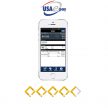
Viewpost Survey Looks At B2B Electronic Payments
[fusion_text]50 percent of businesses prefer electronic payments to checks, according to a new Viewpost survey that looked at B2B payments. ‘The Checks No Longer in the Mail” study interviewed entrepreneurs and financial professionals to examine their preferred methods of payment. The survey detected a strong move towards electronic migration, and reflected how important electronic payments are to businesses.
Judging by the survey results, it might not be long before electronic payments takeover check payments as the number one method. At the time of the survey, check payments accounted for 37 percent of transactions, and electronic payments were not far behind at 35%.
Entrepreneurs Embracing Electronic Payments
The research also revealed that most of the entrepreneurs interviewed had ‘embraced some form of electronic payments,’ 30 percent had introduced electronic payments and invoicing, while 36% of business owners were planning to introduce e-payments in the future.
Although electronic payments offer greater efficiency and security, these aren’t the only reasons businesses owners were keen to make the switch. 55.2 percent of executives stated that receiving electronic payments improved their confidence in their job performance. And just over 10 percent said it played an important role in their purchasing decisions.
Sixty percent of entrepreneurs also stated they could be enticed to open a new bank account if they were given special offers for electronic payments and invoices, and 80% felt that integrating a bank account with invoicing and payments would help to improve their cash flow management.
Max Eliscu, CEO of Viewpost, said:
“Our data clearly shows that traditional invoicing—and the entire antiquated, old-school payments process—are a big pain point.”
ACH Payments on the Increase
Figures from 2015 show that ACH transactions grew by 1.3 billion to 24 billion in 2015 – an increase of 5.6 percent growth on 2014’s figures. One of the biggest changes was in the volume of B2B payments. CTX transactions climbed by 7.2 percent, CCD transactions increased by 8.2 percent and healthcare payments grew by 39 percent.
The State of B2B Payments 2015: Emerging Business Value predicted that the amount of ACH payments would continue to grow through 2016, with 39 percent of businesses stating they had plans to increase their use of these payments.
The Viewpoint survey delivered similar results to previous research. Back in 2014, an Association for Financial Professionals survey showed that half of treasury and finance professionals still used checks for B2B transactions, however, it also indicated that 48 percent of those surveyed were planning to switch to e-payments within three years.
Barriers to Electronic Payments
Although B2B businesses are clear on the benefits of changing to e-payments, such as improved fraud control and better cashflow, the costs of upgrading to an electronics payment system were viewed as one of the major barriers.
In addition, many businesses – especially small enterprises – lack the funds to upgrade. Others don’t view upgrading as a necessity while they still have the capacity to accept checks, and there is also difficulty in getting some suppliers to accept e-payments.
Declining Check Use
Despite the many predictions, it seems business owners aren’t quite ready to give up their check books, and despite their declining use, the death of the check isn’t imminent quite yet.
Although the Viewpoint survey demonstrates that e-payments are fast catching up with checks, it also showed how 100 percent of business owners still write paper checks. Additional research also shows there has been a limited revival in check use and a slight increase in their use among businesses.
However, the biggest reason for businesses still relying on checks was due to some suppliers not having the ability to accept electronic payments, while others said they trusted paper checks as they were no hidden fees.
Job Creation and Economy
Electronic payments are increasingly important to businesses for aiding cashflow, boosting efficiencies, reducing costs and providing employment opportunities. The advances in e-payments means they are increasingly being used, and the move to e-payments has been beneficial to job creation. It is estimated electronic payments are creating one in five jobs, and Moody’s estimate that 2.6 million jobs were created every year as a direct result of e-Payments.
Globally, electronic payments are estimated to add US$296B to GDP, and as they offer greater convenience to consumers, shoppers are also likely to spend more.
Cost Saving Advantages of Electronic Payments
As well as playing a role in job creation, e-payments also offer cost saving advantages. A 2015 survey conducted by The Association for Financial Professionals detailed how B2B organizations were moving towards electronic payments as they are much more affordable to process.
The research estimated that check payments averaged at $3.00 per transaction, while ACH payments could cost as little as $0.26 each.
The research also highlighted how most B2B companies were prepared to turn their backs on traditional paper payments, with 80 percent of those surveyed stating they were making the transition.
Commenting on the study, Jim Kaitz, AFP President and Chief Executive Officer, said:
“Treasury and finance departments are increasingly tasked with innovating and adapting to better serve their organizations, and moving from paper to electronic is one way to do so.”
Conclusion:
The Viewpost survey shows an undeniable rise in electronic payment usage, but check payments remain comparatively strong for now. However, with most B2B buyers deciding to buy online, offering electronic payment options is going to be of greater importance to companies in this niche.
As noted in the survey, the climb in e-payments continues to gather pace. Although some business owners stated they don’t intend to change to electronic payments at any point, if they want to cut costs, boost efficiency and want a more secure method of payment, then offering electronic payment methods is likely to become an essential business move.
Statistics show 68 percent of B2B buyers are now purchasing online, and Forrester predict that B2B eCommerce will exceed $1 trillion by 2020. The trend towards electronic payments is set to continue, and depending on check book payments might not be enough for the modern business.[/fusion_text]
Ready to get started?
Get in touch or create an account





